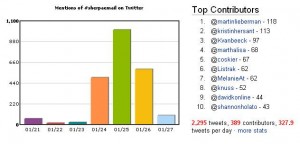Email Summit 2011: Your peers’ top takeaways about email content, enhancing deliverability and optimizing swag
For everyone who made it out to the MarketingSherpa Email Summit 2011 this past week at Caesar’s Palace in Las Vegas, you know ;). And everyone who couldn’t attend this year, you missed some great sessions, case studies, speeches and interaction with around 750 of your peers.
What happens in Vegas …

Unless some #SherpaEMAIL folks hit me up *cough @mgieva @martinlieberman cough* this is my evening in #SinCity - phintch
Everyone probably knows the second half of this advertising tagline (hint: what happens, stays), but that’s pretty hard to achieve with real-time blogging (I had posts up on Flint McGlaughlin and David Meerman Scott‘s talks with almost no lead time) from both Sherpa and attendees, crazy-active Twitter hashtag activity (#SherpaEmail) and entire rooms of marketers uploading pictures and video all day long.
We even brought along some of our optimization experts from MECLABS to do one-on-one live optimization of email, landing pages and more (see below) …
Crowdsourced takeaways
A great thing about a successful Email Summit filled with engaged attendees is that reactions to individual sessions and the entire event go online in real-time.
Here’s just a small sample from all the great material this Summit generated:
Email Summit notes shared by Alison Chandler, Marketing Manager American Association for the Advancement of Science.
Here’s some of the material Alison is sharing:
- Slides: http://www.sherpastore.com/related-page-3921.html
- MarketingSherpa’s 2011 Award Winners Special Report – PDF
http://www.marketingsherpa.com/article.php?ident=31815 - Wrapups across the web
MarketingSherpa Email Summit takeaways
http://emailblog.eu/2011/01/26/marketingsherpa-email-summit-takeaways/Photos
http://hashalbum.com/sherpaemailSmart Network Data Services
https://postmaster.live.com/snds/
- Exclusive content gives people a reason to fork over their email addresses. Make at least some of the content in your emails available ONLY to email subscribers (such as special discounts), or FIRST to email subscribers (such as the chance to buy tickets before the general population).
And be sure to check out Alison’s “random gems” at the link.
Key MarketingSherpa Email Summit takeaways from Emailblog.eu — this is a great collection of Twitter commentary
Live Blog: How Pandora Uses Email Marketing to Keep You Listening from EE Tech News
More from EE Tech News — Live Blog: Email Marketing Summit, Real-Time Marketing and PR & Inbound Marketing
Summit panelist, Ardath Albee — Make 3rd Party Content an Opportunity Not a Necessity
4 Email Marketing Challenges and How to Tackle Them from Magdalena Georgieva at HubSpot
And do hit the official MarketingSherpa Twitter account to find retweets of even more crowdsourced content and photos from the Summit.
#SherpaEmail
Of course a blog of crowdsourced material would not be complete without taking in all the activity at the Summit’s Twitter hashtag — #SherpaEmail. Some numbers for the seven-day period from 1/21 to 1/27:
- 2,295 tweets
- 389 contributors
- 327.9 tweets per day
Here’s a sample from the top ten tweeters (and yes, I somehow made it onto this list):
- d’OH! We need to educate on the difference btwn spam & unsub. RT @Listrak: 30% of people use spam button to unsubscribe. Ouch.#SherpaEmail – @martinlieberman
- Caesars generated 100K mobile opt-ins easily. Have had 100K app downloads in last year. 15K people have used mobile check-in. #sherpaemail – @kristinhersant
- Simple but effective. Put a newsletter subscribe on every interaction: Signatures, receipts, door clings, splash pages, … #SherpaEmail – @Kvanbeeck
- Think twice about list rentals and purchases, they don’t perform well. Build out your house list, performs MUCH better. #SherpaEmail – @marthalisa
- Post-modern consumers don’t believe marketers. Don’t sell, say. #sherpaemail #emailmarketing – @coskier
- Implement comprehensive email hygiene and correction to maximize the number of addresses on your list. #SherpaEmail – @Listrak
- B2B email addresses tend to be longer thus more prone to typos. #SherpaEmail – @MelanieAt
- What comes first? Message or medium? Start with the message & decide on best medium #SherpaEmail – @knuss
- MarketingSherpa Email Summit 2011 One-on-One Case Study http://t.co/H3rRa1R #SherpaEmail – @davidkonline
- ‘Email is a conversation, not a magazine ad.’ #SherpaEmail – @shannonholato
Optimizing swag
The “more” up there in the live optimation section leads to something probably near, and dear, to most conference and expo veterans’ hearts — swag. At lunch on Wednesday, me and my editor — and Director of Editorial Content MarketingSherpa — Daniel Burstein, sat with Karen Rubin and Magdalena Georgieva of HubSpot and Jessica Best of emfluence and did a little swag optimization.
Sure MECLABS Research Managers and the MarketingExperiments Quarterly Research Journal are the go-to people when you need a better-performing landing page, but who should you turn to in order to make cool swag even cooler? Marketing experts, that’s who.
I’m taking full credit for this one:

Optimizing Swag Real Time (#osrt) at #SherpaEmail @davidkonline: Add a USB drive for an #emailgeek #swissarmyknife - bestofjess
How to optimize this swag from emfluence Interactive Marketing? Easy. Lose the letter opener and add a USB flash drive on the other side of the keyboard brush, and leave the screen cleaner strip alone. Done and done, and voila, you have a Geek Swiss Army Knife. Ah, swag optimization at its best.
These efforts led to this Twitter exchange:
- Optimizing Swag Real Time (#osrt) at#SherpaEmail @davidkonline: Add a USB drive for an #emailgeek#swissarmyknifehttp://twitpic.com/3tnzc8 – @bestofjess
- Had fun optimizing #SherpaEmail schwag @ lunch w/ @KarenRubin@mgieva @DavidKOnline Stop by Emfluence booth for Swiss Army Knife for Geeks – @DanielBurstein
- @bestofjess @DanielBurstein @mgieva@davidkonline My vote is for#optimizedswag – @karenrubin
- @DanielBurstein @mgieva@davidkonline @KarenRubin what other #osrt? Oh! An on/off volume switch for the slingshot monkey. #optimizedswag – @bestofjess
So you can see we have something of a swag-optimizing super group. If you were at MarketingSherpa Email Summit and have your own swag optimization suggestions, feel free to tweet them using #optimizedswag.
And, who could leave out — or forget — the Slingshot SEO monkey:
“I’m walking through the airport and every so often my suitcase screams like a monkey. #sherpaEmail” – @karenrubin
Related resources
Live optimization with Dr. Flint McGlaughlin at Email Summit 2011
Real-Time Marketing: David Meerman Scott at MarketingSherpa Email Summit 2011
MarketingSherpa Email Summit 2011 One-on-One Case Study
Email Summit Case Study: National Education Association’s Member Benefits Corporation










